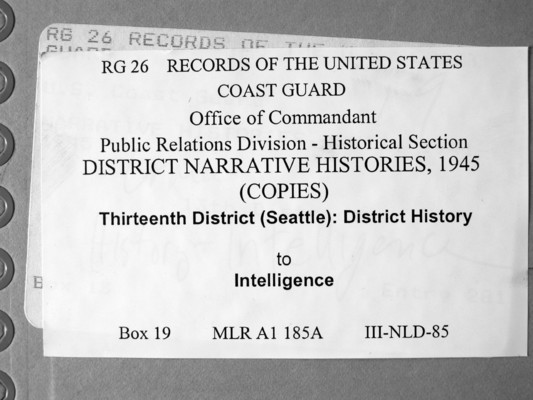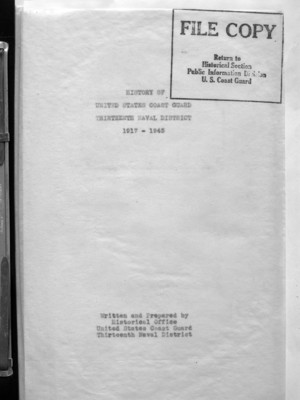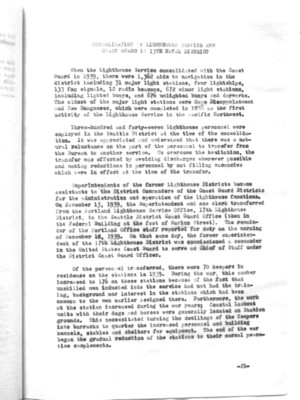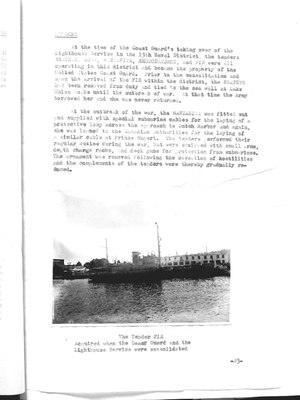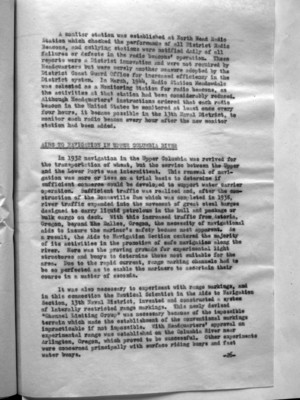Pages That Mention United States
Coast Guard District narrative histories 1945
1
RG 26 RECORDS OF THE UNITED STATES COAST GUARD
Office of Commandant
Public Relations Division - Historical Section DISTRICT NARRATIVE HISTORIES, 1945 (COPIES) Thirteenth District (Seattle): District History
to Intelligence
Box 19 MLR A1 185A III-NLD-85
2
FILE COPY Return to Historical Section Public Information Division U. S. Coast Guard
HISTORY OF UNITED STATES COAST GUARD THIRTEENTH NAVAL DISTRICT 1917 - 1945
Written and Prepared by Historical Office United States Coast Guard Thirteenth Naval District
4
CONSOLIDATION OF LIGHTHOUSE SERVICE AND COAST GUARD IN 13TH NAVAL DISTRICT
When the Lighthouse Service consolidated with the Coast Guard in 1939, there were 1,362 aids to navigation in the district including 31 major light stations, four lightships, 133 fog signals, 12 radio beacons, 672 minor light stations, including lighted buoys, and 676 unlighted buoys and daymarks. The oldest of the major light stations were Cape Disappointment and New Dungeness, which were completed in 1856 as the first activity of the Lighthouse Service in the Pacific Northwest.
Three-hundred and forty-seven Lighthouse personnel were employed in the Seattle District at the time of the consolidation. It was appreciated and understood that there was a natural reluctance on the part of the personnel to transfer from the Bureau to another service. To overcome the hesitation the transfer was effected by avoiding discharges whenever possible and making reductions in personnel by not filling vacancies which were in effect at the time of the transfer.
Superintendents of the former Lighthouse Districts became assistants to the District Commanders of the Coast Guard Districts for the administration and operation of the lighthouse functions. On November 13, 1939, the Superintendent and one clerk transferred from the Portland Lighthouse Service Office, 17th Lighthouse District, to the Seattle District Coast Guard Office (then in the Federal Building at the foot of Marion Street). The remainder of the Portland Office staff reported for duty on the morning of December 18, 1939. On that same day, the former superintendent of the 17th Lighthouse District was commissioned a commander in the United States Coast Guard to serve as Chief of Staff under the District Coast Guard Officer.
Of the personnel transferred, there were 70 keepers in residence on the stations in 1939. During the war, this number increased to 176 on these stations because of the fact that unskilled men inducted into the service had not had the training, background nor interest in the stations which had been common to the men earlier assigned there. Furthermore, the work at the station increased during the war years; Coastal Lookout units with their dogs and horses were generally located on Station grounds. This necessitated turning the dwellings of the Keepers into barracks to quarter the increased personnel and building kennels, stables and shelters for equipment. The end of the war began the gradual reduction of the stations to their normal peactime complements. -22-
6
At the time of the Coast Guard's taking over of the Lighthouse Service in the 13th Naval District, the tenders HEATHER, ROSE, MANZANITA, RHODODENDRON, and FIR were all operating in the district and became the property of the United States Coast Guard. Prior to the consolidation and upon the arrival of the FIR within the district, HEATHER had been removed from duty and tied to the sea wall at Lake Union Locks until the outbreak of war. At that time the Army borrowed her and she was never returned.
At the outbreak of the war, the MANZANITA was fitted out and supplied with special submarine cables for the laying of a protective loop across the approach to Dutch Harbor and again, she was loaned to the Canadian authorities for the laying of a similar cable at Prince Rupert. The tenders performed their regular duties during the war, but were equipped with small arms, depth charge racks, and deck guns for protection from submarines. The armament was removed following the cessation of hostilities and the complements of the tenders were thereby gradually reduced.
(Photo of the Tender Fir displayed here)
The Tender FIR Acquired when the Coast Guard and the Lighthouse Service were consolidated.
-23-
9
A monitor station was established at North Head Radio Station which checked the performance of all District Radio Beacons, and outlying stations were notified daily of all failures or defects in the radio beacons' operation. These reports were a District innovation and were not required by Headquarters but were merely another measure adopted by the District Coast Guard Office for increased efficiency in the District system. In March, 1944, Radio Station Meadowdale was ??? as a Monitoring Station for radio beacons, as the activities at that station had been considerably reduced. Although Headquarters' instructions ordered that each radio beacon in the United States be monitored at least once every four hours, it became possible in the 13th Naval District, to monitor each radio beacon every hour after the new monitor station had been added.
AIDS TO NAVIGATION IN UPPER COLUMBIA RIVER
In 1932 navigation in the Upper Columbia was revived for the transportation of wheat, but the servies between the Upper and Lower Ports was intermittent. This renewal of navigation was more or less on a trial basis to determine if sufficient commerce could be developed to support water carrier operation. Sufficient traffic was realized and, after the construction of the Bonneville Dam which was completed in 1938, river traffic expanded into the movement of great steel barges designed to carry liquid petroleum in the hull and package or bulk cargo on deck. With this increased traffic from Astoria, Oregon, beyond The Dalles, Oregon, the necessity of navigational aids to insure the mariner's safety became most apparent. As a result, the Aids to Navigation Section centered the majority of its activities in the promotion of safe navigation along the river. Here was the proving grounds for experimental light structures and buoys to determine those most suitable for the area. Due to the rapid current, range marking channels had to be so perfected as to enable the mariners to ascertain their course in a matter of seconds.
It was also necessary to experiment with range markings, and in this connection the Nautical Scientist in the Aide to Navigation Section, 13th Naval District, invented and constructed a system of laterally restricted range markings. This newly devised "Channel Limiting Group" was necessary because of the impossible terrain which made the establishment of the conventional markings impracticable if not impossible. With Headquarters' approval an experimental range was established on the Columbia River near Arlington, Oregon, which proved to be successful. Other experiments were concerned principally with surface riding buoys and fast water buoys.
-26-
